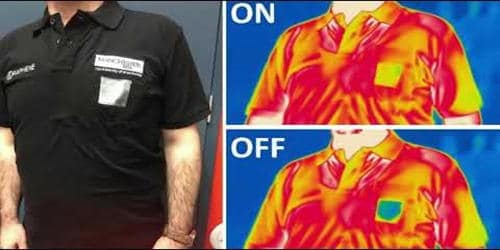New Research on Graphene Smart Textiles for Heat-Adaptive Clothing
Scientists have created a prototype garment to demonstrate dynamic thermal radiation control within a piece of clothing by utilizing the thermal properties and flexibility of graphene. New research on the two-dimensional (2D) material graphene has allowed researchers to create smart adaptive clothing which can lower the body temperature of the wearer in hot climates. The development also opens the door to new applications such as interactive infrared displays and covert infrared communication on textiles.
A team of scientists from The University of Manchester’s National Graphene Institute has created a prototype garment to demonstrate dynamic thermal radiation control within a piece of clothing by utilizing the remarkable thermal properties and flexibility of graphene. Scientists at the University of Manchester have developed a new type of smart textile that could make its way into adaptive clothing that keeps the wearer cool in warm weather, and vice versa. The development also opens the door to new applications such as interactive infrared displays and covert infrared communication on textiles. The material achieves this through the use of graphene which can be tuned to alter the thermal radiation of the textile, with the team imagining the technology could also find its way into advanced displays and even spacesuits.
The human body radiates energy in the form of electromagnetic waves in the infrared spectrum (known as blackbody radiation). In a hot climate, it is desirable to make use of the full extent of the infrared radiation to lower the body temperature that can be achieved by using infrared-transparent textiles. This has the effect of altering the amount of infrared radiation emitted through the material’s surface, which, in one demonstration, enabled it to be tuned to mask the thermal signature of a person’s hand from an infrared camera. As for the opposite case, infrared-blocking covers are ideal to minimize the energy loss from the body. Emergency blankets are a common example used to deal with treating extreme cases of body temperature fluctuation. Now the team is eyeing more of an active role for its tuneable textile. The collaborative team of scientists demonstrated the dynamic transition between two opposite states by electrically tuning the infrared emissivity (the ability to radiate energy) of the graphene layers integrated onto textiles.
Professor Coskun Kocabas, who led the research, said: “Ability to control the thermal radiation is a key necessity for several critical applications such as temperature management of the body in excessive temperature climates. Thermal blankets are a common example used for this purpose. However, maintaining these functionalities as the surroundings heats up or cools down has been an outstanding challenge.”

Graphene smart textiles developed for heat adaptive clothing
Prof Kocabas added: “The successful demonstration of the modulation of optical properties on different forms of textile can leverage the ubiquitous use of fibrous architectures and enable new technologies operating in the infrared and other regions of the electromagnetic spectrum for applications including textile displays, communication, adaptive space suits, and fashion.”
The warmer the human body, the more infrared radiation it emits, so some clothes are designed to allow this radiation to pass through freely to help keep the body temperature low, while others are designed to lock it in to keep the wearer warm. This study built on the same group’s previous research using graphene to create thermal camouflage which would fool infrared cameras. The new research can also be integrated into existing mass-manufacture textile materials such as cotton. To demonstrate, the team developed a prototype product within a t-shirt allowing the wearer to project coded messages invisible to the naked eye but readable by infrared cameras. The team has now adapted its smart textile to perform the role of both, with the ability to dynamically transition between these two states via electrical tuning.
Professor Sir Kostya Novoselov was also involved in the research: “This is a beautiful effect, intrinsically routed in the unique band structure of graphene. It is really exciting to see that such effects give rise to the high-tech applications.” he said.
Advanced materials are one of The University of Manchester’s research beacons — examples of pioneering discoveries, interdisciplinary collaboration, and cross-sector partnerships that are tackling some of the biggest questions facing the planet.














